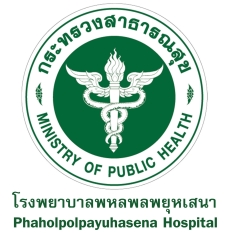กลาสโกว์โคมาสเกลในการพยากรณ์ผลการรักษาผู้ป่วยหลอดเลือดในสมองแตก
บทคัดย่อ
การรักษาสภาวะที่เกิดจากการเลือดออกภายในสมอง (Intracerebral hemorrhage) มีหลายวิธี และขึ้นอยู่กับความรุนแรงของเลือดออก และสถานะทางสุขภาพของผู้ป่วย เพื่อประโยชน์ ในการพยากรณ์ผลการรักษาผู้วิจัยจึงมีแนวคิการนํากลาสโกว์โคมาสเกลมาใช้ในการพยากรณ์ ผลการรักษาผู้ป่วยหลอดเลือดในสมองแตกเป็นการวิจัยแบบ retrospective cohort study การศึกษา ผลการรักษาสภาวะผู้ป่วยหลอดเลือดในสมองแตกเปรียบเทียบระหว่างกลุ่มที่มีกลาสโกว์โคมาสเกล แตกต่างกัน ที่เข้ารับการรักษาในโรงพยาบาลพหลพลพยุหเสนาโดยเก็บข้อมูลย้อนหลังในช่วงปี 2564-2566
ผลการศึกษาพบว่าผู้ป่วยส่วนใหญ่มีอายุเฉลี่ย 59.8 ปี (SD=13.8 ปี) เป็นเพศชาย 64 ราย ร้อยละ 62.1 เพศหญิง 39 ราย ร้อยละ 37.9 มีโรคประจําตัวความดันโลหิตสูง 10 ราย ร้อยละ 9.7 เบาหวาน 6 ราย ร้อยละ 5.8 ผู้ป่วยส่วนใหญ่ไม่มีประวัติโรคเกี่ยวกับหลอดเลือดมาก่อนผู้ป่วย ส่วนใหญ่มาด้วยเรื่องเลือดออกในสมองใหญ่ (Intracerebral hemorrhage) ร้อยละ 94.2 มีเพียงประมาณ 6 รายที่มีเลือดออกบริเวณสมองน้อย และก้านสมอง หรือร้อยละ 5.8 ส่วนใหญ่ ไม่มีการใช้ยาละลายลิ่มเลือด อาการขณะออกจากโรงพยาบาลพบว่า 5 ราย (ร้อยละ 4.9) ที่มีอาการ ไม่ปกติแต่สามารถทํากิจวัตรประจําวันได้ 48 ราย (ร้อยละ 46.6) ผลการรักษาไม่สามารถทํากิจวัตร ประจําวันได้จนถึงป่วยติดเตียง 25 ราย (ร้อยละ 24.4) และพบว่าเสียชีวิต 21 ราย (ร้อยละ 20.4) คะแนนกลาสโกว์โคมาสเกลของผู้ป่วยแรกรับทั้ง 3 กลุ่มมีความแตกต่างอย่างมีนัยสําคัญทางสถิติ p<0.01 โดยกลุ่มที่ปกติหรือทํากิจวัตรประจําวันได้มีคะแนนกลาสโกว์โคมาสเกลสูงที่สุด สรุปผลการศึกษาคะแนนกลาสโกว์โคมาสเกลของผู้ป่วยแรกรับมีความสำคัญในการใช้ พยากรณ์ผลการรักษาในผู้ป่วยหลอดเลือดในสมองแตก โดยพบว่าหากมีคะแนนกลาสโกว์โคมาสเกลสูงกว่า 12 คะแนน จะมีผลการรักษาในระดับที่ผู้ป่วยสามารถทำกิจวัตรประจาวันได้จนถึงอาการปกติหลังการรักษา
เอกสารอ้างอิง
Gill, M. R., Reiley, D. G., & Green, S. M. (2004). Interrater Reliability of Glasgow Coma Scale Scores in the Emergency Department. Ann Emerg Med, 43, 215-223.
Knaus, W. A., Draper, E. A., Wagner, D. P., & Zimmerman, J. E. (1985). APACHE II: A severity of disease classification system. Crit Care Med, 13, 818-829.
Lenfant, F., Sobraques, P., Nicolas, F., Combes, J. C., Honnart, D., Freysz, M. (1997). Use of Glasgow Coma Scale by anesthesia and intensive care internists in brain injured patients. Ann Fr AnesthReanim, 16, 239-243.
Mayer, S. A., Dennis, L. J., Peery, S., Fitsimmons, B. -F., Bernardini, G. L., Commichau, C., Eldaief. (2003). Quantification of lethargy in the neuro-ICU: The 60-Second Test, Neurology, 61(4), 543-545.
Prasad, K. (1996). The Glasgow Coma Scale: A critical appraisal of its clinimetric properties. Journal of Clinical Epidemiology, 49(7), 755-763.
Prasad, K. & Menon, G. R. (1998). Comparison of three strategies of verbal scoring of the Glasgow Coma Scale in patients with stroke. Cerebrovasc Dis, 8, 79-85.
Reilly, P., Simpson, D., Sprod, R., Thomas, L. (1988). Assessing the conscious level in infants and young children: A paediatric version of the Glasgow Coma Scale. Child’s Nerv Syst, 4(1), 30-33.
Rowley, G, Fielding, R. (1991). Reliability and accuracy of the Glasgow Coma Scale with experienced and inexperienced users. Lancet, 337, 535-538.
Hulley SB, Cummings SR, Browner WS, Grady D, Newman TB. Designing clinical research : an epidemiologic approach. 4th ed. Philadelphia, PA: Lippincott Williams & Wilkins; 2013. Appendix 6C, page 79.
Vathanalaoha K, Oearsakul T, Tunthanathip T. Predictive Factors of Survival and 6-Month Favorable Outcome of Very Severe Head Trauma Patients; a Historical Cohort Study. Emerg (Tehran). 2017;5(1):e24. Epub 2017 Jan 10. PMID: 28286831; PMCID: PMC5325893.
C. J. WEIR and others, The prognostic value of the components of the Glasgow Coma Scale following acute stroke, QJM: An International Journal of Medicine, Volume 96, Issue 1, January 2003, Pages 67–74, https://doi.org/10.1093/qjmed/hcg008
Reith FCM VdBR, Synnot A, Gruen R, Maas AIR. The reliability of the Glasgow Coma Scale: a systematic review. Intensive Care Med. 2016; 42:3-15.
ดาวน์โหลด
เผยแพร่แล้ว
รูปแบบการอ้างอิง
ฉบับ
ประเภทบทความ
สัญญาอนุญาต
ลิขสิทธิ์ (c) 2022 โรงพยาบาลพหลพลพยุหเสนา

อนุญาตภายใต้เงื่อนไข Creative Commons Attribution-NonCommercial-NoDerivatives 4.0 International License.
บทความที่ได้รับการตีพิมพ์เป็นลิขสิทธิ์ของโรงพยาบาลพหลพลพยุหเสนา
ข้อความที่ปรากฏในบทความแต่ละเรื่องในวารสารวิชาการเล่มนี้เป็นความคิดเห็นส่วนตัวของผู้เขียนแต่ละท่านไม่เกี่ยวข้องกับโรงพยาบาลพหลพลพยุหเสนาและบุคลากรท่านอื่น ๆ ในโรงพยาบาลฯ แต่อย่างใด ความรับผิดชอบองค์ประกอบทั้งหมดของบทความแต่ละเรื่องเป็นของผู้เขียนแต่ละท่าน หากมีความผิดพลาดใด ๆ ผู้เขียนแต่ละท่านจะรับผิดชอบบทความของตนเอง





